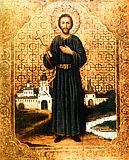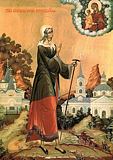

| Previous day | Next day |
| Old Style
January 24
|
Saturday |
New Style
February 6
|
| 35th Week after Pentecost. Tone 1. | No fast.
|
![]() St. Xenia of Rome and her two female slaves (ca. 457).
St. Xenia of Rome and her two female slaves (ca. 457). ![]() St. Xenia of St. Petersburg, fool-for-Christ (19th c.).
St. Xenia of St. Petersburg, fool-for-Christ (19th c.).
Martyrs Babylas of Sicily and his two disciples Timothy and Agapius (3rd c.). St. Macedonius, hermit of Mt. Silpius, near Antioch (ca. 420). Translation of the relics of Monk-martyr Anastasius the Persian (7th c.). St. Gerasim, bishop of Perm (ca. 1449). Martyr John of Kazan (1529). St. Dionysius of Olympus and Mt. Athos (1541). St. Sophia, first abbess of Shamordino Convent (1888). Blessed Valentina (Sulkovskaya) of Minsk (1966).
Martyrs Paul, Pausirius, and Theodotian, of Egypt (3rd c.). St. Felician, bishop of Foligno in Italy (254). St. Philo, bishop of Carpasia on Cyprus (5th c.). St. Lupicinus of Lipidiaco (Gaul) (500). St. Zosimas of Cilicia, bishop of Babylon in Egypt (6th c.). St. Neophytus the Recluse, of Cyprus (1214).
Repose of Bishop Nektary (Kontzevitch) of Seattle (1983).
Thoughts for Each Day of the Year
According to the Daily Church Readings from the Word of God
By St. Theophan the Recluse

Saturday. [Col. 1:3-6; Luke 16:10-15]
Ye cannot serve God and mammon. A divided thought and divided heart make a person unfit for anything; for A double-minded man is unstable in all his ways (James 1:8). He either does nothing, or does and redoes; that is, he builds with one hand and destroys with the other. The source of a truly God-pleasing life is a firm resolution to please God in all things. This resolution directs all of a person’s thoughts, desires and feelings toward one thing, and thus uniting his inward [powers], it makes him strong to do deeds, bringing unity into all of his activities and imparting to them a single character. Such deeds are successful and fruitful, because they are full of true life. Where do inertia, immobility and fruitlessness of deeds come from? From inner lifelessness; and inner lifelessness comes from inner division. One single goal is not acknowledged or established as a law of life—deeds are performed haphazardly. Therefore one deed goes in its direction, another goes in another direction, and the edifice of one’s life is never erected. Choose a goal and devote your life to it. The true, main goal is indicated by the God-like nature of man; it is living communication with God. Direct also toward this main goal all personal, scholarly, worldly, civic, commercial, official, and governmental goals. If everyone in society held to this [principle], there would be one general tenor to society, and one spirit would fill everyone.
Articles
 St. Macedonius the Hermit of SyriaSaint Macedonius, a Syrian hermit, lived during the end of the fourth century and the beginning of the fifth. |
 Martyrs Paul, Pausirius, and Theodotian, of EgyptThe Holy Martyrs Paul, Pausirius, and Theodotion lived in Egypt during the third century. |
 St. Philon, Bishop of Kolpasteia, CreteSaint Philon, Bishop of Kolpasteia (Crete) He died peacefully in the fifth century. |














